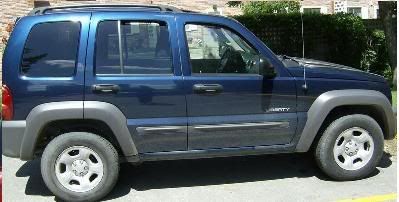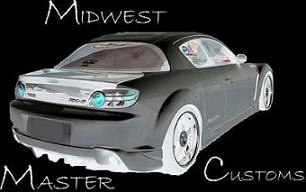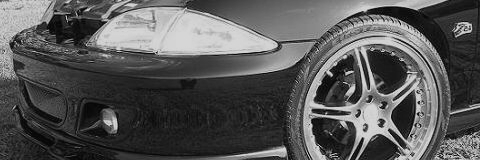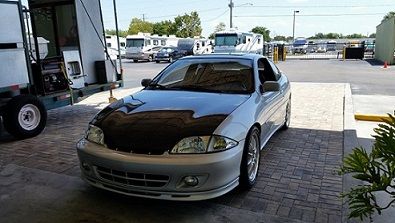MidwestMasterCustoms wrote:short answer NO, As i have come to understand it a heat range on a spark plug is its ability to TRANSFER heat away from the plug and to the head so a hotter plug will transfer more heat a colder plug will transfer less heat it has nothing to do with you A/F ratio.
J~
Yup, running a hotter plug would not lean out the motor, or change the air/fuel mixture at all.
Spark Plugs explained
Introduction:
The spark plug's location exposes it to extreme temperature variations, chemicals, fuels and oils. It is also attacked by cylinder pressures produced by the piston and cam timing, then it is also assaulted by high-output ignition units. As a result of all of this, one can effectively learn what the engine is doing by reading the firing end of the spark plugs.
By careful examination of the plug's color, gap, and any deposits that reside on it, you will be shown the efficiencies as well as deficiencies of what is going on in the engine. Spark plugs should be checked at least yearly, and replaced as often as necessary. In most cases you can follow the manufacturers recommendations, but in a race car, our replacement intervals are quite frequent.
back to top
--------------------------------------------------------------------------------
How a Spark Plug Works:
The basics of a spark plug is that it must perform two primary functions.
To Ignite the Air/Fuel mixture
To REMOVE the heat out of the combustion chamber
Spark plugs transmit electrical energy that turns fuel into working energy. A sufficient amount of voltage must be supplied by the ignition system to cause the spark to jump the across the spark plug gap, thus creating what is called Electrical Performance.
Additionally, the temperature of the spark plug's firing end must be kept low enough to prevent pre-ignition, but high enough to prevent fouling. This is called Thermal Performance and is determined by the heat range of the spark plug.
It is important to understand that spark plugs CANNOT create heat, only remove it! The spark plug works as a heat exchanger, pulling unwanted thermal energy away from the combustion chamber and transferring the heat to the engine's cooling system. The heat range is defined as a plug's ability to dissipate heat. The rate of heat is determined by:
The insulator nose length
Gas volume around the insulator nose
Materials and/or construction of the center electrode and porcelain insulator
Now to the actual function: As the Ignition is triggered it sends the spark through the rotor, to the cap, down the wire and then it jumps the gap of the spark plug, a spark kernel is created that ignites the air/fuel mixture in the combustion chamber. Proper timing of this spark is not the only concern as described above. You must have the proper heat range (described later) as well as the correct gap.
Opening The Plug Gap:
On weaker or stock ignitions, opening up the gap CAN increase the spark kernel size, thereby creating a more efficient burn. The problem lies in that any added gap creates more strain on the other ignition parts.
Coils may not have enough stored energy to fire, or in the least case, not enough energy to cross the gap, creating a miss-fire.
Plug wires will break down due to the added resistance as the spark tries to reach ground.
Rotor and Cap, as well as points (if you still have an interest in prehistoric ignitions), and the carbon bushing in the center of the distributor cap will show early failures.
All of this is because the greater the gap and the higher the voltage requirement to jump the gap. Do not forget the gap between the rotor arm to the distributor cap too. A high performance rotor is a bit longer at the tip, allowing less spark loss or chance of spark scatter in the cap as the spark attempts to jump the plug gap.
As many of us know that race, it is also possible to slow down a car if the gap is too big. I will get into this later when I describe proper spark plug gaps.
back to top
--------------------------------------------------------------------------------
Spark Plug Heat Range:
A spark plug's heat range has no relationship on the actual voltage transferred through the spark plug. Rather, the heat range is a measure of the spark plug's ability to remove heat from the combustion chamber. The heat range measurement is determined by several factors:
The length of the ceramic center insulator nose
The insulator nose's ability to absorb and transfer combustion heat
The material composition of the insulator
The material composition of the center electrode
The longer the insulator nose gives you a larger surface area exposed to combustion gasses and heat is dissipated slowly. This also means the firing end heats up more quickly. We are talking about exposed ceramic length, not extended tip length.
The insulator nose length is the distance from the firing tip of the insulator to the point where the insulator meets the metal shell. Since the insulator tip is the hottest part of the spark plug, the tip temperature is a primary factor in pre-ignition and fouling. No matter what the plugs are installed in, be it a lawnmower, a boat, your daily driver or your race car, the spark plug tip temperature must remain between 450°C to 850°C. If the tip temperature is lower than 450°C, the insulator area surrounding the center electrode will not be hot enough to deter fouling and carbon deposit build-ups, thus causing misfires. If the tip temperature exceeds 850°C, the spark plug will overheat which can cause the ceramic around the the center electrode to blister as well as the electrodes will begin to melt. This may lead to pre-ignition/detonation and expensive engine damage. (see the plug pictures that are part of this article)
In identical spark plugs, the differences from one heat range to the next is the ability to remove approximately 70°C to 100°C from the combustion chamber. A projected style spark plug firing temperature is increased by 10°C to 20°C.
The firing end appearance also depends on the spark plug tip temperature. There are three basic diagnostic criteria for spark plugs: good, fouled, and overheated. The borderline between the fouling and optimum operating regions (450°C) is called the spark plug self-cleaning temperature. This is the temperature point where the accumulated carbon and combustion deposits are burned off automatically.
Bearing in mind that the insulator nose length is a determining factor in the heat range of a spark plug, the longer the insulator nose, the less heat is absorbed, and the further the heat must travel into the cylinder head water journals. This means that the plug has a higher internal temperature, and is said to be a "Hot" plug. A hot spark plug maintains a higher internal operating temperature to burn off oil and carbon deposits, and has no relationship to spark quality or intensity.
Conversely, a "Cold" spark plug has a shorter insulator nose and absorbs more combustion chamber heat. This heat travels a shorter distance, and allows the plug to operate at a lower internal temperature. A colder heat range can be necessary when an engine is modified for performance, subjected to heavy loads, or it is run at high RPMs for significant periods of time. The higher cylinder pressures developed by high compression, large camshafts, blowers and nitrous oxide, not to mention the RPM ranges we run our engines at while racing, make colder plugs mandatory to eliminate plug overheating and engine damage. The colder type plug removes heat more quickly, and will reduce the chance of pre-ignition/detonation and burn-out of the firing end. (Engine temperatures can affect the spark plug's operating temperature, but not the spark plug's heat range).
back to top
--------------------------------------------------------------------------------
Influences on Spark Plug Temp and Performance:
Below is a list of possible external influences on a spark plug's operating temperatures. The following symptoms or conditions may have an affect on the actual temperature of the spark plug. The spark plug cannot create these conditions, but it must be able to deal with all the levels of heat, otherwise performance will suffer and engine damage can occur:
Air/Fuel Mixtures seriously affect engine performance and spark plug temps.
Rich air/fuel mixtures cause tip temperature to drop, causing fouling and poor drivability.
Lean air/fuel mixtures cause plug tip and cylinder temperatures to increase resulting in pre-ignition, detonation, and possibly serious spark plug and internal engine damage.
It is important to read spark plugs many times during the tuning process to achieve optimum air/fuel mixture. Computer-controlled engine applications do a pretty good job of this with the various sensors that report back to the ECM.
Higher Compression Ratios and Forced Induction will elevate spark plug tip and in-cylinder temperatures.
Compression can be increased by performing any one of the following modifications:
a) reducing combustion chamber volume (i.e.: domed pistons, smaller chamber heads, milling heads, etc.)
b) adding forced induction (Nitrous, Turbocharging, Supercharging)
c) camshaft change
As compression increases, a colder heat range plug is required, as well as higher octane fuel and paying careful attention to ignition timing and air/fuel ratios are also necessary.
Advanced Ignition Timing: Advancing timing by 10° causes plug temperature to increase by approximately 70°C to 100°C.
Engine Speed and Load: Increases in firing-end temperatures and are proportional to engine speed and load. When traveling at a constant high rate of speed, or carrying/pushing very heavy loads, a colder heat range spark plug should be installed.
The heavier your vehicle or greater the amount of work the engine sees (racing applications, construction trucks, vans, RVs & Motorhomes, etc.), the more critical this becomes.
Ambient Air Temperature:
As air temperature falls, air density volume increases, resulting in leaner air/fuel mixtures. This creates higher cylinder pressures and temperatures that causes an an increase in the spark plug's tip temperature. Fuel delivery should be increased.
As temperature increases, air density decreases, as does intake volume, and fuel delivery should be decreased.
Humidity: As humidity increases, air volume decreases. The result is lower combustion pressures and temperatures, causing a decrease in the spark plug's temperature and a reduction in available power. Air/Fuel mixture should be leaner, depending on ambient air temperature.
Barometric Pressure and Altitude:
Affects the spark plug's temperature
The higher the altitude, the lower the cylinder pressure becomes. As the cylinder temperature decreases, so does the tip temperature.
Many tuners attempt to "chase" tuning by changing spark plug heat ranges.
The real answer is to play with the jetting or air/fuel mixtures in an effort to put more air back in the engine.
back to top
--------------------------------------------------------------------------------
Spark Plug Types and Designs:
There are hundreds of different spark plug types designed for different engines as well as specific applications. The two main ones we use in racing are the standard tip and extended tip. It is my opinion that any time you can use the extended tip, do it! The longer tip gets the spark kernel started further into the center of the bore for a more complete combustion process. This is also achieved with the better aftermarket cylinder heads on many available engine applications. The newer heads position the spark plug location closer to a more optimum location.
But, there are also specially designed spark plugs that are supposed to increase the spark kernel size. You see, the larger the spark kernel that is generated by the spark jumping the electrode gap, the more complete burn, the better power and efficiency and the smoother the car will run for longer periods of time. These specially designed plugs will have multiple angles that allow the spark to find the easiest path as well as getting the spark kernel out from under the ground electrode which can quench the kernel size limiting it's size and expansive growth.
Of these plugs, there are those that work, those that are hype, and those that are a great idea but they are manufactured by companies whose only purpose is profit instead of quality. Use common sense and don't believe all the hype that a marketing company bombards you with.
One thing to be wary of is plug material. Of the plugs I've tested, the fine-wire gold plugs have made the best power, but at the price of a short life, which requires short replacement intervals. The Platinum plugs are only good for longevity, though most imports run better with a platinum plug. This has to do with the material of the cylinder head and engine block and the plugs ability to properly ground.
People always ask my plug recommendations. I must say that I like the NGK V-Power Plugs, the Champion Premium Fine-Wire Gold plugs, and the Nippondenso U-Groove plugs for domestics. In the Imports, the Bosch or NGK Platinum plugs usually work best. I have been testing the AC RapidFire plugs currently and I must say I am impressed by the results. Plugs that are useless to me are the Split-Fire plugs (poor materials -- actually an Autolite plug with the "V" tip), and of course the Autolite plug itself. I have seen the most failures and poor performance out of these plugs. This is not a bash session, so those of you that love your Split-Fires or Autolites, I'll wait for you at the finish line ... <G>
back to top
--------------------------------------------------------------------------------
RFI or "Radio Frequency Interference":
Many people believe that spark plugs fire instantly. This is partly true because they fire in milliseconds, although if one looks at an oscilloscope pattern you will see much more than a single instantaneous firing event. Many things also occur that you cannot see even with the oscilloscope. Part of what you cannot see, but can in many cases hear, is the noise that is picked up in the speakers of your car stereo. This is called RFI, or Radio Frequency Interference.
Spark Plug Firing Voltages:
When the breaker points or solid state ignition unit (switching device) interrupts current flow in the primary ignition circuit and induces current flow into the secondary windings of the coil, there is an instantaneous voltage spike. (as seen in the illustration at right in position A to B). This represents the voltage required to overcome the spark plug and distributor rotor gaps. Once the spark gaps have been bridged, the secondary voltage required to sustain the spark across the gap is much less and drops (as seen in position B to C above). The spark continues to arc across the gap at more or less constant voltage until the arc is extinguished (at position D above). This is due to coil energy drop in that it can not sustain the spark any longer. During this arc duration (Spark Duration), the plug actually fires several times. This is caused by high frequency oscillations in the primary and secondary windings of the coil, which continues to induce voltage spikes. They continue and slowly diminish (positions D to E above) even after they are no longer strong enough to sustain spark. All of this takes place in roughly one thousandth of a second.
With our race designed ignition units, they concentrate their efforts on sustaining spark duration as well as limiting the voltage drop after the gaps have been bridged. Most aftermarket ignitions concentrate on giving us 20° of spark duration (crank degrees) as well as much higher spark energy output. A high performance coil helps this out, but the Capacitive discharge and digital ignition units assist in storing and delivering this power through the coil more efficiently, faster and give the ability to achieve higher RPMs more safely and efficiently in fuel mixture burning. The coil is only the pawn of the ignition trigger or control unit. The coil is the real workhorse and takes most of the abuse ... make sure you use a good coil.






